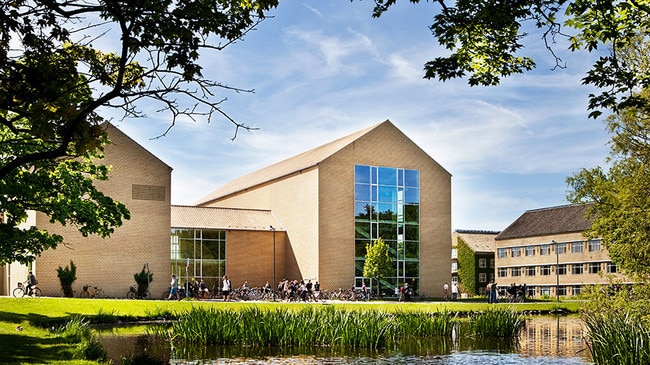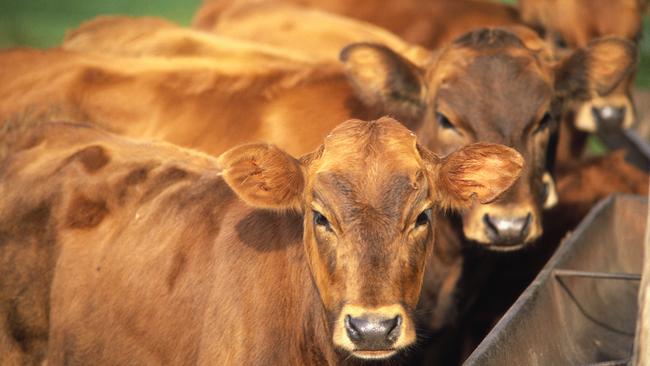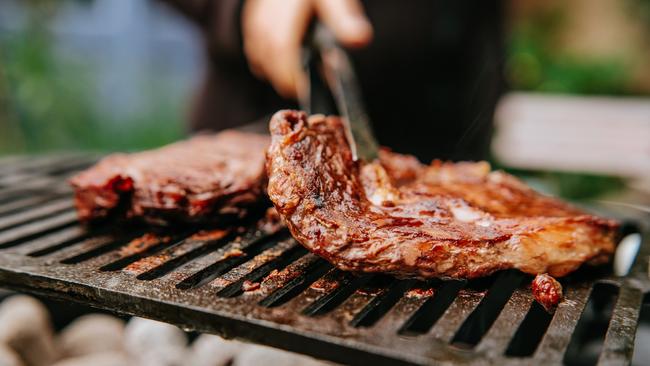How much extra would you pay for the privilege of eating meat?
In Denmark, where the average person consumes about 93kg of meat a year, convincing people to eat less meat is no mean feat. This is how the government has taken action.
Every day we lived in Aarhus, Denmark, my partner and I would frequent the local Aarhus University cafeteria and raid its incredible fresh-food buffet.
For as little as $9, we were treated to an array of plant-based delicacies: fresh, seasonal salads, soups and pasta dishes, sprinkled with delightfully pungent cheeses and spices, ready to be garnished with pickled vegetables (onions, gherkins), seeds and toppings my boyfriend referred to as “crunchies”.
At the end of the long buffet sat the freshly baked breads in all of their dark, rye glory, ready to be cut into chunks and slathered with Lurpak butter. The meats – a small variety compared to the vegetable dishes – were off to the side and in limited quantity. They were also not covered by the $9, commanding a higher price more in line with the impact on our health – and the environment.
Aarhus University’s choice to offer primarily plant-based meals extends beyond its student cafeteria: according to the university’s contracts manager, Camilla Høgenhaven Andersen, “all catering for conferences and meetings organised and paid for by Aarhus University must, as a starting point, be vegetarian. You can, however, still choose meat if you wish”.
The policy, which came into effect in August 2022, is part of the city’s broader plan to become carbon neutral by 2030. As the consumption of food and beverages accounts for 26 per cent of emissions from Danish households (second only to transport), food is a key focus of the strategy – and it includes shifting people away from red meat to plants.

“We have adopted a climate political food strategy, which generally has three goals until 2025: a 25 per cent reduction of the CO2 footprint of purchased food; to generate less food waste, and; to make more climate-friendly foods in purchasing agreements,” Aarhus Mayor Jacob Bundsgaard tells me.
He has since introduced an internal climate tax that applies only to municipality-run businesses, schools, childcare centres and aged-care homes, on foods such as beef and lamb, ready-made meals made with meat, as well as juices and soft drinks (which are consumed in such a large amount they are responsible for a third of all emissions).
Beef is the most carbon-intensive protein, generating 49.9kg of CO2 equivalent, or CO2e, per 100g of protein, equivalent to the amount in four steaks. Lamb and mutton are the second-most intensive, generating 19.9kg of CO2e per 100g of protein.
Because all council-run businesses use a centralised portal to purchase foods, the Mayor and his team have been able to effectively price items of food according to how much CO2 they emit.
“So when childcare centres, schools, elderly homes, etc, are buying food from our internal grocery store, they see a price per item of food that combines its CO2 emissions with its market price,” say economist consultants Jeppe Deleuran and Rasmus Lillelund Lovring, who were put in charge of implementing the internal climate tax.
The tax works like this: an additional 1000 Danish kroner ($219) is added per ton of CO2 emissions, or 1 Danish kroner ($0.22) per kilogram. So if you’re a nursing home chef buying beef, that equals about 32.5 kroner (or $7) per kilo, according to Denmark’s climate data table, Conctios.
Along with implementing the tax, Aarhus also organised plant-based cooking courses for chefs to help them come up with meat-free dish ideas. “We offer courses on how to cook with lentils, vegetables and legumes, because the culture in Denmark has not been to cook with plants,” says Lovring. “We want to show people you can still cook great foods with plants.”
Nearly two years later, the results speak for themselves. “Within a year, beef purchases were down 40 per cent – it’s been replaced by lower-carbon meats such as pork, chicken and vegetarian alternatives,” the economists say.
“We are not trying to punish people or get them to change from meat to vegetarian – that’s too big. We just want people to cut back on how much beef they are eating, and gradually look to introduce a tax on pork and other meats. But that’s still a while away.”
What’s happening within Aarhus is a local example of a much larger, more national approach towards transitioning Danes away from meat-heavy meals. In 2023 Denmark introduced its Action Plan for Plant-Based Food – the only one in the world – which lays out the country’s commitment to normalising plant-rich diets, as well as incentivising the production of more vegetables and alternative-proteins.
Danish MP and former environment minister Ida Auken says that for a meat-heavy country such as Denmark, where the average person consumes about 93kg of meat a year (24kg of that beef and 26kg pork), and where the majority of people (57 per cent) have no interest in eating less meat, convincing people to eat less meat, especially beef and pork, is no mean feat.
“We are one of the biggest meat eaters in the world, and a country that is heavily based on animal production,” she says. But Auken believes this doesn’t mean the government shouldn’t try to shift people’s attitudes – and tastebuds – when it comes to food. “If we want to produce more food on less land, more space for nature, more climate-friendly consumption, and have a healthier population, we must do something,” she tells me.

The 40-page action plan covers the entire food chain – from organic root vegetables to processed dairy substitutes and fermented fungi – and considers the role of everyone in food consumption and production, from schools to culinary colleges to local governments, hospitals, farmers, restaurants and private businesses, and stresses the importance of collaboration between partners who have traditionally been in opposition.
“We are trying to get everyone to move in the same direction,” Auken says. “We have transformed the dietary guidelines to reflect eating with a lower climate footprint, which means all public institutions are changing their in-house foods. We are also working with the education sector to train chefs to include more techniques for preparing plant-based foods, not just meat.”
All ministries involved in food, such as business, research and higher education, and exports (Denmark is one of the world’s biggest producers and exporters of pork) are also working together to advance the agenda. The government has introduced a Plant-based Food Grant – a $195m fund for the plant-based transition available up to 2030 – and redirected funding to universities to focus more on plant food research.
“We are trying to make a systemic change, and for that to happen you need a strong narrative that is backed by tangible action,” Auken says.
In Australia, the story is a little different. Like the Danes, we eat a huge amount of meat: 134kg per person, most of it poultry (49kg) but a large amount of beef (26kg) and also lamb (8.5kg), which are ruminant livestock that produce methane, the main greenhouse gas in the grazing system. But our population size, geographical composition and economic attachment to beef make it that much harder to advance any plant-eating agenda.
Australia is the world’s fourth-largest exporter of beef, and supplies half the world’s sheep meat. Forecasts suggested Australia could become the second-largest exporter of beef in 2024, especially after record demand from the US. “We have vast interests of the meat industry to contend with,” says Dr Diana Bogueva, from the Curtin University Sustainability Policy Institute, and the author of Food in a Planetary Emergency.
“A good start to paying more attention to plant-based food and sustainability will be the new national dietary guidelines, which are due to be updated in 2026.”
The guidelines review, carried out by the National Health and Medical Research Council, will for the first time integrate environmental sustainability considerations, as well as update the “lean meat and alternatives” food group to recommend plant sources of protein in preference to animal sources.
“This is a big step forward in bringing Australia closer to the Scandinavian model, protecting
public health and safety, and helping Australians make more informed choices about the food they eat and the environmental footprint their food has,” Bogueva says.
Helen Vidgen, associate professor in public health nutrition at Queensland University of Technology, agrees, and stresses the guidelines are the “benchmark that everything gets measured against”.
“All the food that goes into feeding people in nursing homes, hospitals, schools, etc, will be formulated according to these new guidelines,” she says. Vidgen, whose background is in public health policy, says the last time Australia attempted to put together a national nutrition policy was in 1992, outlining “what sort of things we will research, what public health policies we want, and what are the goals we are trying to achieve from a nutritional perspective”.
Australia’s siloed approach to food and nutrition also poses an issue. Professor Jolieke van der Pols, from the Centre for Agriculture and the Bioeconomy at QUT, says that having multiple departments, from agriculture, exports, health and education, as well as a federated system of two tiers of governments, stops us from having a “centrally co-ordinated food policy”.
Because the food industry in Australia represents a big part of our economy, any major changes, proposed and implemented, draw attention. Earlier this year, Red Meat Advisory Council chair John McKillop accused the NHMRC of straying beyond its remit for focusing on sustainability. “These developments are an overreach by the dietary guidelines expert committee that go well beyond the policy intent of the Australian Dietary Guidelines to provide recommendations on healthy foods and dietary patterns,” he said at the time.

When asked whether the Danish model could work in Australia, McKillop told this masthead it could not, as the “nations’ agricultural systems and geographies are completely different”.
“Australia’s livestock production systems are characterised by low-density, extensive grazing on large areas of land, with the dominant systems being beef cattle, sheep meat and wool production. This contrasts with Denmark’s highly intensive and densely stocked farming methods, primarily focused on poultry, pork and dairy cattle.”
According to the Meat and Livestock Association’s State of the Industry report, Australians working in beef cattle, sheep farming and feedlots accounted for 130,250 jobs in 2022-23, while the processing sector accounted for 30,306 jobs. The red meat and livestock industry’s turnover totalled $81.7bn in 2022-23, accounting for approximately 1.6 per cent of Australia’s total key industry turnover – this includes beef, sheep meat and goat meat.
“Australians love their red meat … perceptions of the Australian red meat industry by everyday Australians are strong … with 79 per cent of metro consumers believing the beef industry is an important part of the Australian economy,” he says.
McKillop adds that for Australian red meat production, the net greenhouse gas emissions have decreased by 78 per cent since 2005.
“The amount of water used to produce a kilo of beef has reduced by 73 per cent since 1985, and Australia’s grazed agricultural lands are increasing in woody vegetation cover, and the conversion of primary forest to other land uses has also declined by more than 90 per cent from 1990 levels. This means more carbon storage and habitat for biodiversity,” he says.
Bogueva recalls the furore after some researchers floated that “by not taxing meat production and consumption appropriately, governments are in fact subsidising environmental and public health destruction”. “In the end it was just academics talking into the wind,” she says.
As with Denmark, none of the experts advocate for a total meat ban, but rather for Australians to consider adopting a flexitarian diet. Just reducing red meat consumption, they say, would be a great start for not only the environment but also for health, as beef, lamb and pork have been classified as a Group 2A carcinogen, meaning they probably cause cancer.
“In Europe, we can see a big change in consumer attitudes towards becoming more vegetarian, flexitarian, and starting to consume more different varieties of food, such as plant-based foods,” Bogueva says. “This, however, is unusual for Australia, as our diet is predominantly meat-focused, and meat is going to be big, no matter what dietary guidelines we have.”




To join the conversation, please log in. Don't have an account? Register
Join the conversation, you are commenting as Logout